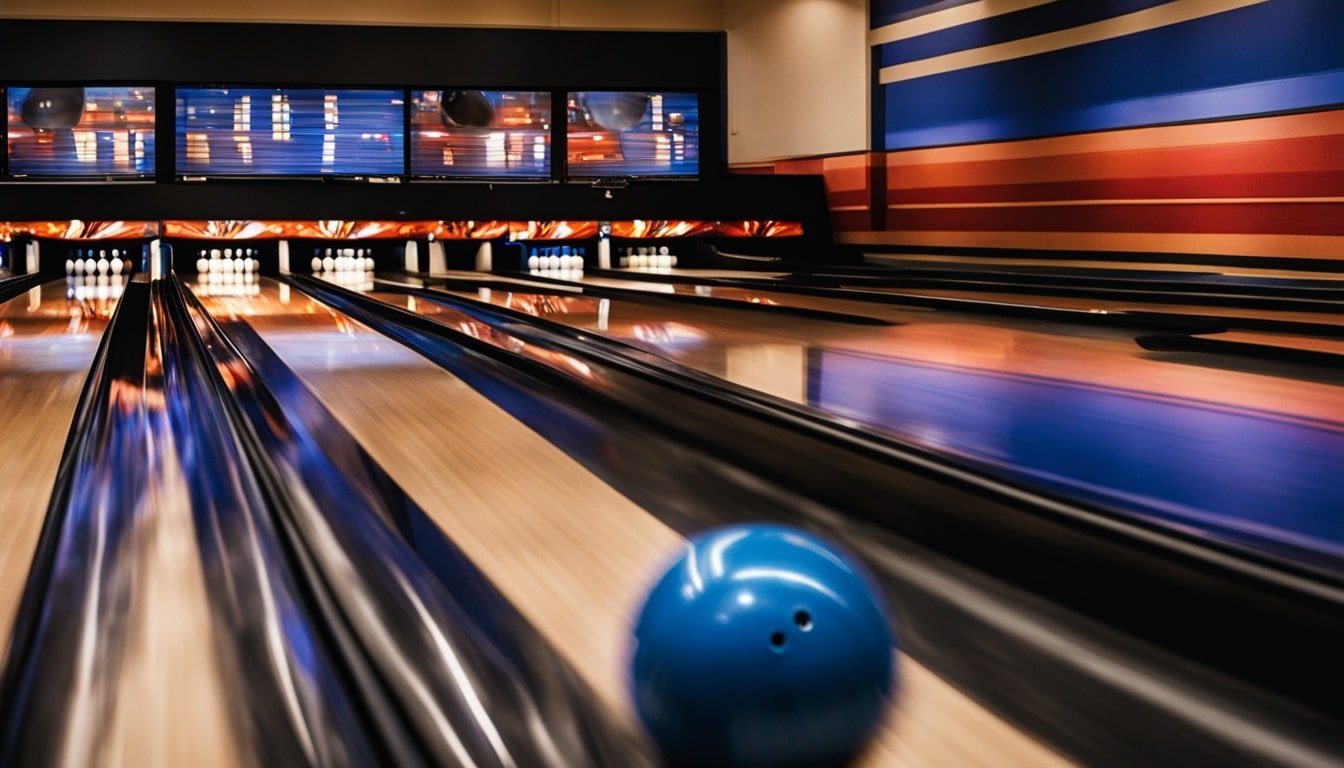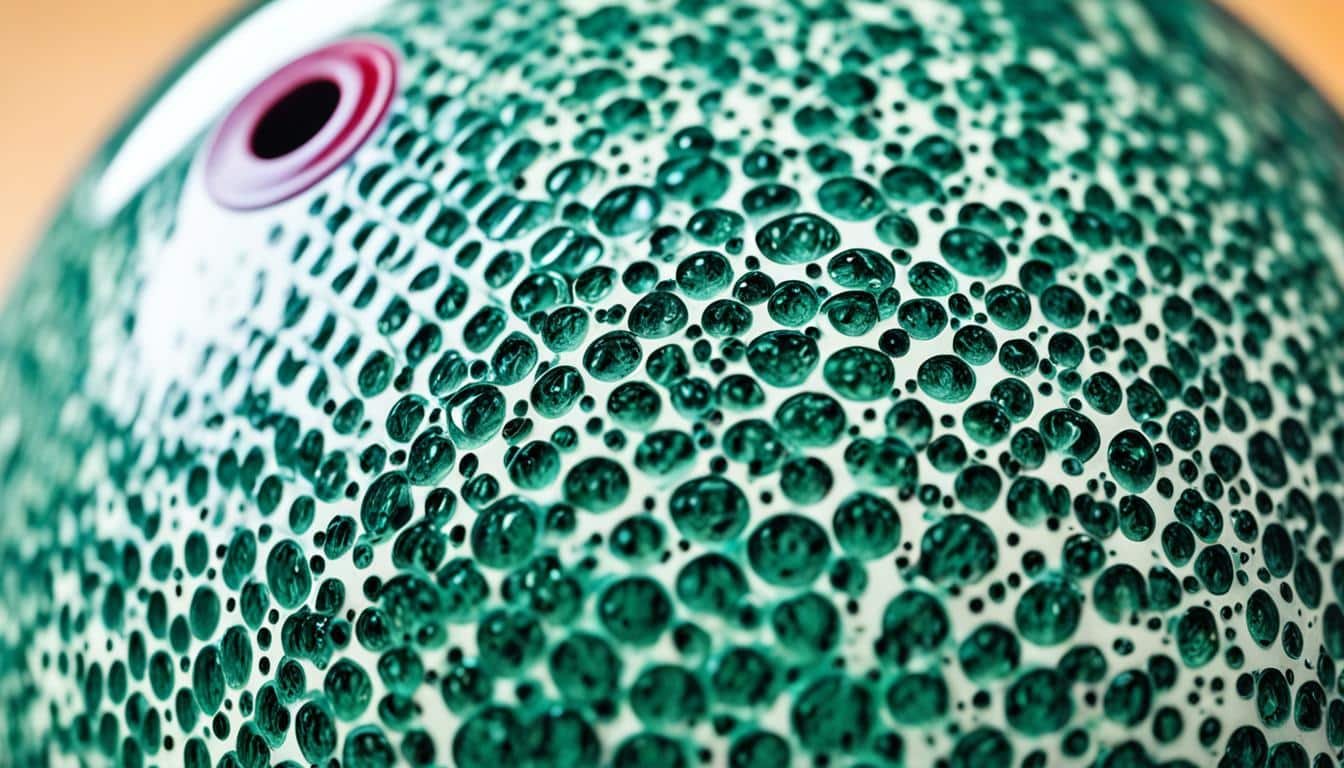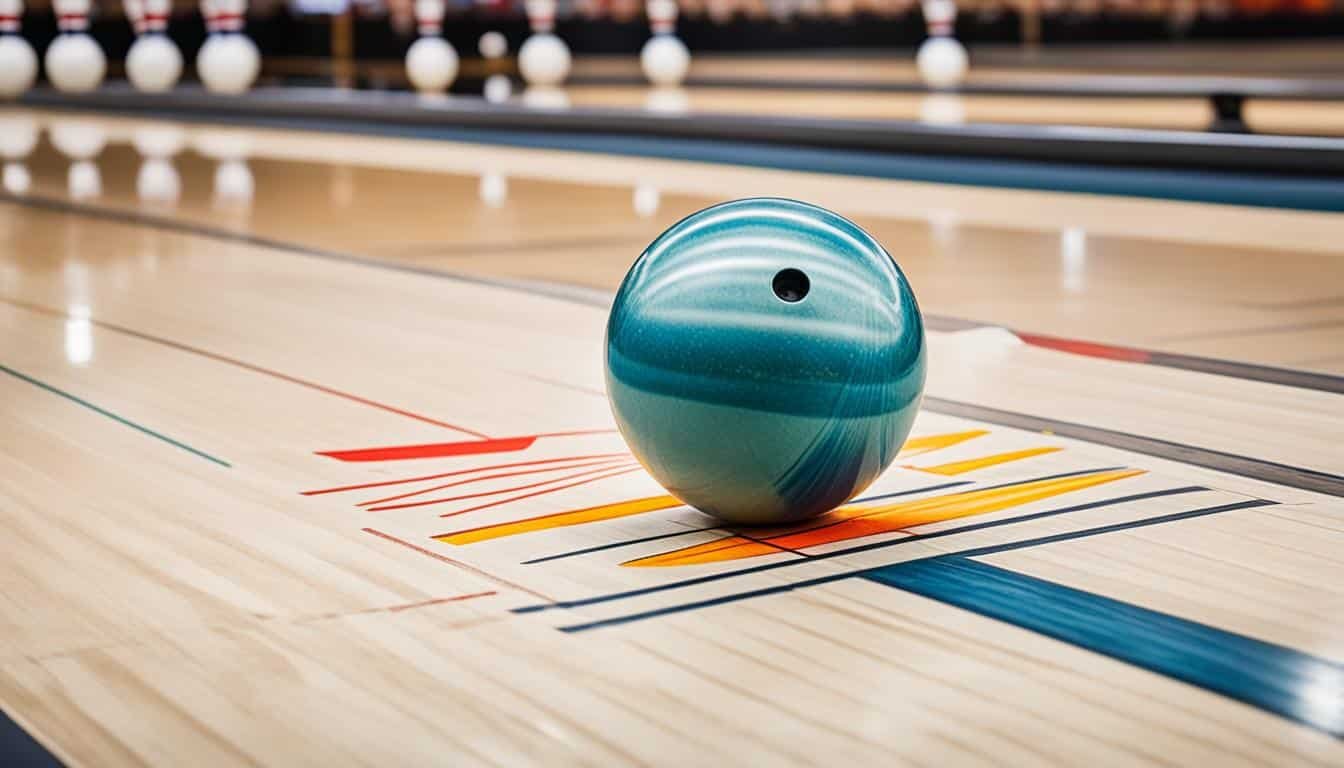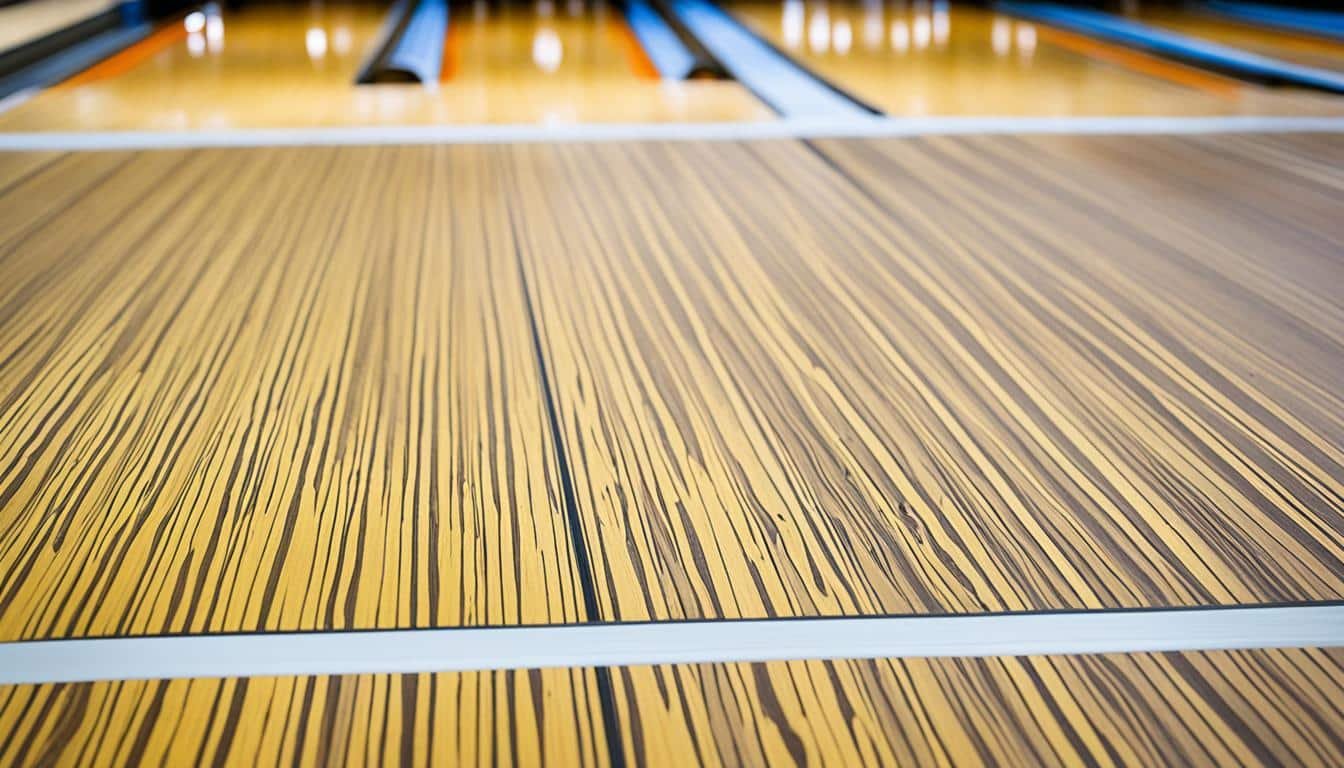Mastering the skill of spinning and curving the ball is key for any bowler. It helps intermediate bowlers improve their game. They can get more accurate and consistent on the lanes. This article will give tips and methods for spinning and curving the ball. It will also cover common mistakes to avoid and advanced techniques to try. Learning and mastering spin and hook can make bowlers of all levels stand out in the sport.
Key Takeaways
- The fundamentals of spin and hook in bowling are essential for improving accuracy and consistency.
- Proper grip, release, and body positioning are crucial for generating spin and hook on the ball.
- Techniques like the hook shot and backup ball can help bowlers curve the ball effectively.
- Factors like ball speed, surface finish, and drilling layout can significantly impact a bowler’s spin and hook potential.
- Understanding lane conditions and matching the ball to the environment are key to maximizing spin and hook performance.
Understanding Spin and Hook
Learning how to spin and hook a bowling ball is key for bowlers at an intermediate or advanced level. Spinning a ball means applying a rotational force as it rolls down the lane. Hooking is when you make a ball curve more by moving it in a specific way. These skills boost accuracy, consistency, and performance on the lanes.
Defining Spin and Hook
Spin is the force that makes a bowling ball roll in a certain direction. It comes from how you release the ball, your grip, and your body position. More spin means a bigger curve or hook.
The hook is the curve a ball takes down the lane. It’s caused by spin, the ball’s weight, its surface, and the lane conditions. A good hook can make a bowler more accurate and hit more pins, especially on tough lanes.
The Importance of Spin and Hook in Bowling
- Improved accuracy: Spin and hook help bowlers control the ball’s path for consistent shots.
- Increased versatility: Knowing these techniques lets bowlers adjust to different lanes and patterns.
- Enhanced scoring potential: A good hook can help knock down more pins in tough situations.
- Competitive edge: Being good at spin and hook gives bowlers an advantage over others, especially at higher levels.
Understanding spin and hook can greatly improve a bowler’s game. It leads to better performance and success on the lanes.
Mastering the Basics
Before you get into advanced techniques, it’s key to get the basics right. This includes your grip, release, body positioning, and approach. These are crucial for control, consistency, and performance.
Grip and Release Techniques
The way you hold the bowling ball affects how much spin you can put on it. Using a fingertip grip helps with control and spin. Also, how you release the ball matters. Aim for a smooth, controlled release to ensure the ball rolls off your fingers consistently.
Body Positioning and Approach
- Keep your body positioning balanced and consistent during your delivery. Make sure your weight is evenly spread and your shoulders face the target.
- Work on a consistent approach. This helps you repeat your steps and timing for a controlled and accurate release.
- Focus on the fundamentals of your approach. This includes your starting position, step patterns, and timing. These can greatly affect your spin and hook.
Mastering these basic techniques sets you up for better ball-handling skills. You’ll be able to curve and spin the ball more effectively.
Techniques for Curving the Ball

As bowlers get better at the basics, they can try advanced techniques to make their ball curve and spin. The hook shot and the backup ball are two key shots for this.
The Hook Shot
The hook shot means releasing the ball with an upward motion. This makes it curve back towards the lane’s center. It needs the right grip, release, and body positioning.
By adding the right spin and curve, bowlers can beat tough lane conditions. This shot helps bowlers outsmart their opponents.
The Backup Ball
The backup ball curves in the opposite direction from the hook shot. It’s great for surprising opponents or adjusting to lane changes. Learning this shot means changing your strategies and adjustments in your approach and release.
Getting good at both the hook shot and the backup ball boosts a bowler’s versatility and performance. These advanced techniques need time and practice. But, they make the game more dynamic and strategic.
Common Mistakes to Avoid
As bowlers aim to improve their spin and hook, it’s key to watch out for common mistakes. These errors can really slow down their progress. By avoiding them, bowlers can see big improvements in their consistency and overall performance.
One big mistake is forcing the ball too hard. This can make it go off track or lose speed. It’s important to keep your motion smooth and follow through right for the best spin and hook.
Another mistake is releasing the ball at the wrong timing. Releasing it too late or too soon can reduce the spin or hook. This leads to unpredictable results. Bowlers should work on a steady release and timing for better accuracy and effectiveness.
Lastly, not being consistent with your approach and release can hold you back. Keeping a steady technique and follow through is key for reliable spin and hook on the lanes.
“Mastering the fundamentals and avoiding these common mistakes is the key to unlocking your full potential as a bowler.”
By paying attention to these mistakes and focusing on consistency, bowlers can greatly improve their spin and hook. This will boost their overall performance on the lanes.
The Role of Bowler’s Hand

As a bowler, your hand and arm swing are key to controlling and powering the ball. Using a fingertip grip instead of a traditional one can boost leverage and rev rate. This leads to more hook potential.
Your hand does more than just grip the ball. Rotating your fingers at release adds axis rotation. This creates a strong side roll, making the ball spin and hook more. Learning these hand and wrist moves is vital for bowlers aiming for better control and spin.
Grip and Fingertip Position
Choosing a fingertip grip means your hand and fingers touch the ball the most. This grip boosts your rev rate and hook potential. It gives you more leverage and a dynamic release, key for adding spin and curve.
Axis Rotation and Side Roll
At release, rotating your hand and wrist is crucial. Rotating your fingers makes the ball hook sharply with a big side roll. This technique requires practice but pays off with more spin and hook.
“Mastering the hand and wrist techniques is essential for bowlers who want to maximize the spin and curve of their deliveries.”
Ball Speed and Hook Potential

Bowling ball speed is key to creating hook. Throwing the ball slower usually means more hook than throwing it fast. Yet, learning to control your speed is crucial. It lets bowlers change how much hook they get.
By working on their speed, bowlers can improve their spin and curve. This matches the lane conditions and their goals. Having control over ball speed and hook potential is essential.
It’s important to find the right balance between ball speed, hook, and potential. This balance boosts a bowler’s control, consistency, and skill. With practice, bowlers can use ball speed to improve their performance on the lanes.
| Ball Speed | Hook Potential |
|---|---|
| Slower | Higher |
| Faster | Lower |
“The key to unlocking your full potential as a bowler lies in the perfect balance of ball speed and hook control.”
Choosing the Right Bowling Ball

Finding the right bowling ball is key to improving your spin and hook. The ball’s core, coverstock, and surface finish greatly affect how it curves. These features can make a big difference in your game.
Ball Performance Specifications
When picking a bowling ball, think about these important factors:
- Ball Core: The core shape affects the ball’s hook and overall action. Asymmetric cores lead to more hook than symmetric ones.
- Coverstock Material: The type of coverstock, like reactive resin or solid reactive, changes the ball’s hook and performance on different lanes.
- Surface Finish: The surface’s smoothness or roughness changes how much the ball grips the lane and its hook.
Ball Maintenance and Resurfacing
Keeping your ball in good shape helps it hook better as the coverstock wears off. Clean it regularly with the right cleaner and resurface it now and then. This keeps its performance up and boosts your spin and hook.
| Ball Specification | Impact on Performance |
|---|---|
| Asymmetric Core | Increases hook potential and makes the ball move more aggressively |
| Reactive Resin Coverstock | Improves grip and hook on various lanes |
| Rough Surface Finish | Boosts friction and hook, best for dry lanes |
Knowing about bowling ball specs and how to keep them up can make your spin and hook better. This leads to higher scores and a better bowling experience.
Adjusting Surface Finish

Adjusting the surface finish of a bowling ball is often overlooked but crucial for performance. The surface finish greatly affects the ball’s hook potential and motion on the lane. Learning to adjust this can greatly improve a bowler’s control, consistency, and versatility.
As bowling balls wear out, they move smoothly and hook early. Polishing or sanding them helps them keep energy longer, making a more angular motion. Adjusting the surface finish lets bowlers tailor their hook and control to different lanes and their style.
Finding the right balance between surface polish and surface roughness is key. A highly polished ball works well on oily lanes but not on dry ones. A ball with too much grit is hard to control, leading to inconsistent throws. Mastering surface adjustment can greatly improve a bowler’s performance and versatility.
| Surface Finish | Ball Motion | Lane Conditions |
|---|---|---|
| Highly Polished | Smooth, Less Hook | Oily |
| Moderately Sanded | Balanced, Moderate Hook | Medium-Oily |
| Heavily Sanded | Angular, More Hook | Dry |
Learning to adjust their bowling ball’s surface finish lets bowlers unlock new levels of control, consistency, and versatility. This technique helps them match lane conditions and personal style, giving them an edge over others.
“The key to consistent ball motion is understanding how to manipulate your equipment. Adjusting the surface finish is a game-changer for any serious bowler.”
Drilling Layout and its Impact
In competitive bowling, the way a bowling ball is drilled greatly affects a bowler’s performance. The drilling affects the ball motion, hook potential, and control on the lanes. A skilled pro shop operator can greatly improve a bowler’s spin and curve.
The drilling layout is about the holes drilled into a bowling ball. It can be set up for more angular or smooth motion, and it changes the hook the ball makes. Bowlers can adjust their equipment to match their style and the lanes better by understanding drilling layouts.
- Drilling layout can influence the ball’s hook potential and overall performance.
- Adjusting the drilling pattern can create a more angular or smooth ball motion.
- Working with a knowledgeable pro shop operator is key to finding the optimal drilling layout for a bowler’s needs and playing style.
The drilling layout is a key part of customization that helps bowlers reach their best on the lanes. By working with experts and trying different layouts, bowlers can find the right mix of hook, control, and performance to improve their game.
Bowler and Lane Conditions

In bowling, the lane’s oil pattern and surface friction affect how a bowler spins and hooks the ball. Knowing how lanes and balls work together is key to improving your game.
Understanding Lane Patterns
Lane patterns show where and how much oil is on the lane. This affects the ball’s movement. Rev-dominant bowlers do well on lanes with more friction and less oil. On the other hand, speed-dominant bowlers do better on lanes with less oil, where the ball hooks less.
Matching Ball to Lane Conditions
Choosing the right bowling ball is crucial for good spin, hook, and performance. Consider the ball’s versatility, friction, and lane oil when picking your ball. Matching your ball to the lane’s conditions helps you score more consistently felt press web batsman national cowboy team us man cricket definition cap 2.
- Learn how lane patterns and oil change ball hook and spin
- Change your ball selection to fit the lane conditions
- Use your ball’s versatility to excel on different lane surfaces
“The key to consistent, high-scoring bowling is understanding how the lane conditions interact with your ball’s performance and making the necessary adjustments.”
Also Read : What Are The Key Responsibilities Of A Basketball Coach?
Conclusion
Learning to spin and curve a bowling ball can really change the game for an intermediate bowler. It can take their skills to a whole new level. By getting the grip, release, and body position right, and trying out advanced moves like the hook shot, bowlers can get better at hitting their targets.
Choosing the right ball, adjusting to the lane’s surface, and knowing the lane conditions also help a lot. With hard work and practice, bowlers at any level can master the spin and curve. This can help them beat their opponents and reach new heights in bowling.
This article has given a detailed guide on how to improve your bowling skills. It covers everything from the basics to the finer points of spin and hook. By using the tips and techniques shared here, bowlers can boost their performance and reach their goals on the lanes.
FAQs
Q: What is the meaning of spin in bowling?
A: In bowling, spin refers to the rotational movement imparted on the bowling ball as it rolls down the lane. It can significantly affect the ball’s trajectory and how it interacts with the pins.
Q: How can a bowler improve their hook?
A: A bowler can improve their hook by adjusting their grip and release technique, practicing with different bowling balls, and focusing on their footwork to create better leverage and angle when delivering the ball.
Q: What is a good example of a professional bowler who uses a strong hook?
A: A good example of a professional bowler known for their strong hook is Pete Weber. His technique and ability to generate spin have made him one of the top bowlers in the history of the sport.
Q: Can you relate the history of bowling to the development of spins and hooks?
A: Yes, the history of bowling shows that as the sport evolved, bowlers began experimenting with their techniques, leading to the development of spins and hooks to increase their chances of striking down pins effectively.
Q: What is the origin of the term ‘bowler’ in relation to bowling?
A: The term ‘bowler’ originates from the sport itself, defining a person who bowls. The word has become widely recognized in both casual and professional contexts within bowling communities.
Q: How does the dictionary define a bowler?
A: According to the dictionary, a bowler is a noun that refers to an individual who participates in the game of bowling, either in a recreational or competitive capacity.
Q: What are some popular techniques for improving spin and hook in bowling?
A: Some popular techniques include practicing with a consistent release point, using the correct finger placement, and experimenting with different bowling balls that have varying core designs to enhance spin and hook.
Q: What role does gear play in a bowler’s ability to spin and hook?
A: Gear, such as the type of bowling ball and the bowling shoes, plays a crucial role in a bowler’s ability to generate spin and hook. Using the right equipment can significantly impact performance and results.
Q: How can bowlers use TV broadcasts to improve their skills?
A: Bowlers can learn by watching professional matches on TV, analyzing the techniques of successful bowlers, and applying those strategies to their own game to improve their spin and hook.
Q: What is an example of a drill to improve a bowler’s hook?
A: An example of a drill to improve a bowler’s hook is the ‘two-step drill,’ where bowlers focus on their footwork and release while practicing a controlled hook to enhance their overall technique.
